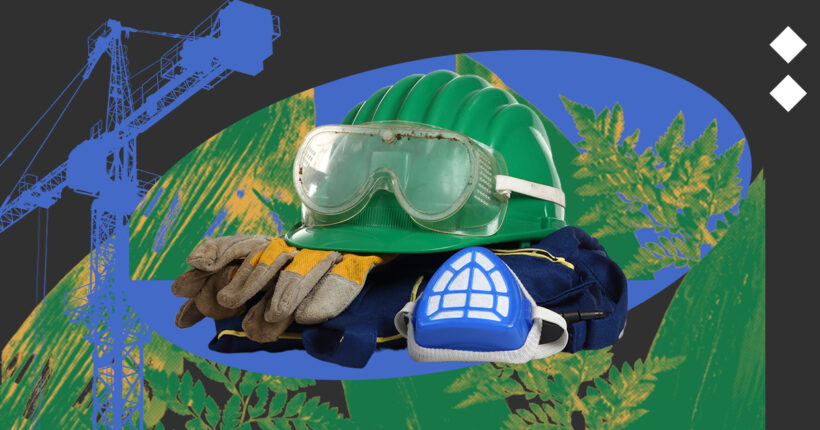
What is the problem?
According to the European Commission, the environmental and infrastructure damage caused by the Russian war in Ukraine amounts to over 52 billion euros (as of August 2023). Unfortunately, the aggressor is still carrying out a brutal war in Ukraine, causing loss of life and further devastation.
According to Hennadiy Fareniuk, the director of the State Research Institute of Building Structures, nearly 160,000 buildings and structures have been destroyed due to Russian aggression in Ukraine, with around 20,000 of them being multi-story buildings (as of October 2023).
Ukraine still has much rebuilding to do, but the European Union has expressed willingness to assist financially and with technical aid. This topic was the main focus of the international conference on Ukraine's "green" recovery, which took place in Vilnius.
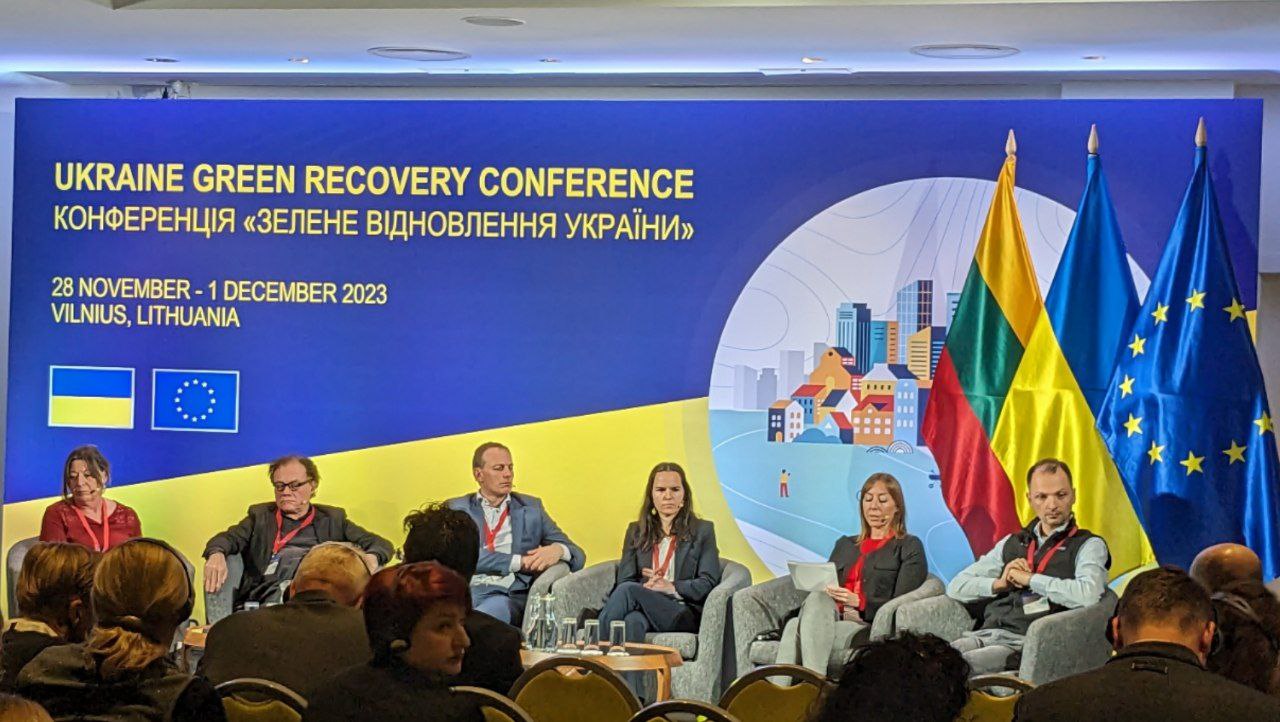
Left to right: Moderator Lynn Barratt, Eddy Deruwe from the Flemish Energy and Climate Agency, Paul Van Rosmalen from the Municipality of Rotterdam, Monica Ruiz Roso and Lidia Lopez from the Regional Government of Extremadura, and Andreas Sedlmair from INSTAGRID GmbH. Olena Bakonina took the photo for Rubryka.
What is the problem?
In his opening remarks at the conference, European Commissioner for Environment, Oceans and Fisheries Virginius Sinkevičius emphasized the need to prioritize ending the war. However, once the war ends, focusing on rebuilding with a strong emphasis on environmental sustainability is crucial. This is essential for securing long-term prosperity.
Therefore, it is necessary to implement a "green" reconstruction of Ukrainian territories with our European partners' help and expertise. This can be accomplished through the construction of sustainable buildings and ecological infrastructure.
Svitlana Berzina, leader of the Civic Council and president of the All-Ukraine NGO "Living Planet," discussed the benefits of "green" reconstruction.
She mentioned that building a "green" building would result in an estimated 2% increase in design and construction expenses compared to a traditional one. Nonetheless, the yearly costs for electricity and heating are reduced by 25%. As a result, the payback time for the extra costs of constructing a "green" building is three years.
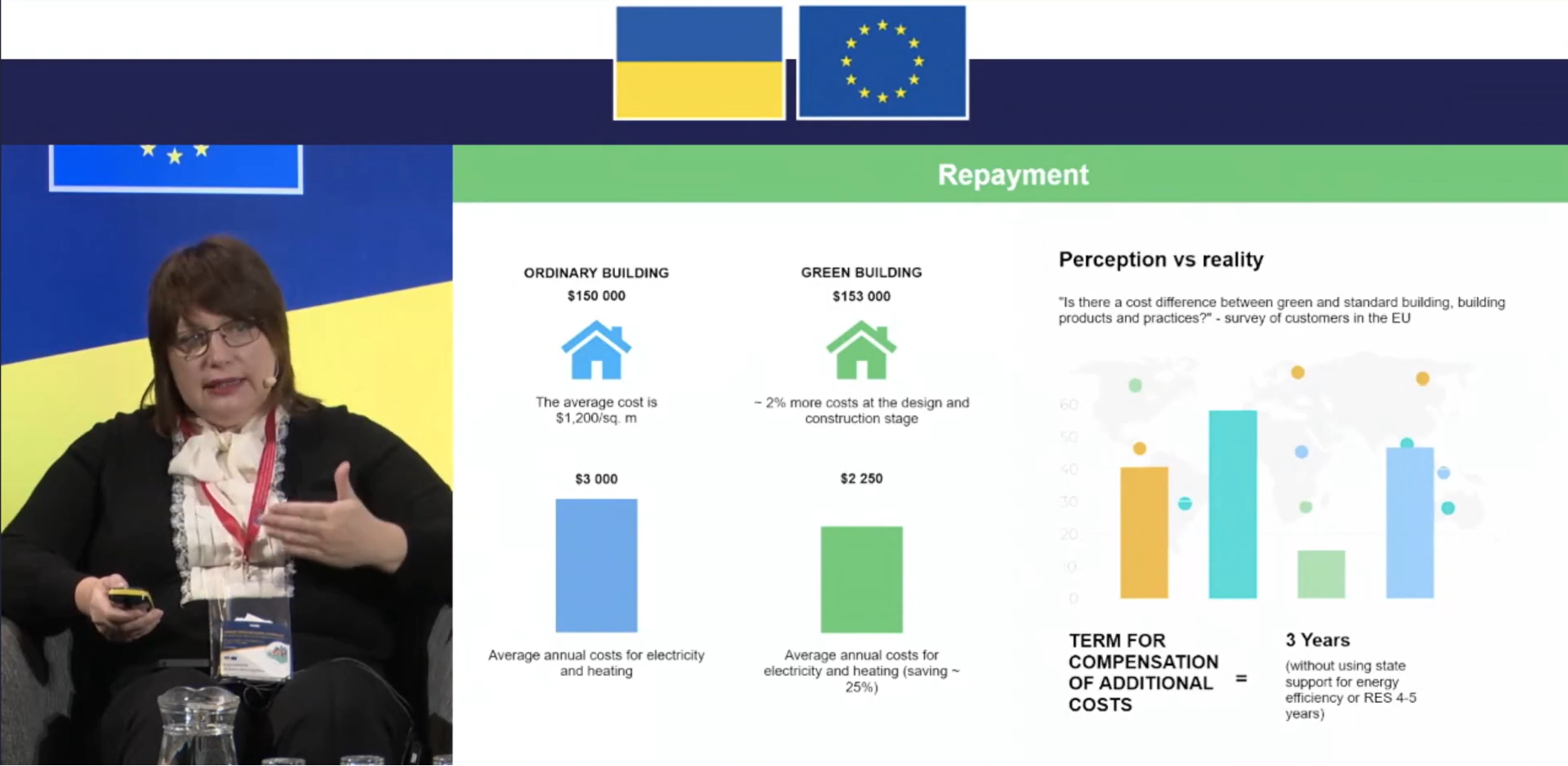
In her presentation, Svitlana Berzina shows the benefits of a "green" building.
Additionally, there are substantial environmental advantages, such as protecting ecosystems and preserving biodiversity while also mitigating soil erosion through sustainable greening practices.
Furthermore, Svitlana Berzina reports that there has been an improvement in the quality of the internal environment, with reductions of:
- 9-50% in morbidity,
- 9-20% in infectious respiratory diseases,
- 18-25% in allergies and asthma,
- and 20-50% in non-specific well-being and discomfort.
"Green buildings use less energy and water, which reduces strain on networks and opens up possibilities for improved infrastructure. As a result, they can decrease greenhouse gas emissions by up to 35%, energy consumption by 30-40%, and water consumption by 20-30%. These sustainable buildings can even provide a 20% return on investment just by improving their energy efficiency," the expert explained.
Additionally, during the conference, representatives from EU countries discussed their eco-friendly solutions and expressed their willingness to collaborate with representatives from Ukrainian cities to offer support for "green" reconstruction.
Use of recycled and natural materials for construction
Monica Ruiz Roso and Lidia López, representatives from the Regional Government of Extremadura in Spain, spoke about their experience utilizing recycled raw materials to restore and construct buildings with low carbon emissions.

During her presentation, Monica showed how cork, cellulose, and kenaf appear in their natural environments and when used as building materials (shown in the bottom row of pictures)
Monica Ruiz Roso discussed the implementation of cork and cellulose insulation in buildings and using kenaf (hemp hibiscus) as an insulation material.
She says these materials have excellent thermal properties and can be obtained from local products or products with much potential for use in the local area.
"Cork, a material derived from cork oak, is commonly used locally. It is known for its lightweight, affordability, and user-friendly properties. The design and production of cork is highly advanced in Portugal and Spain, where it is also the primary source of cellulose insulation, made from recycled paper," stated Monica.

In her presentation, Lydia Lopez shows what natural materials were used for constructionLydia López discussed the development of three social housing units in Ribera del Fresno that prioritize minimal energy usage and construction expenses while also reducing carbon emissions and implementing green and circular economy principles.
"Natural materials were used for construction. The walls are made of compressed earth blocks. Cork, kenaf, and recycled paper were used as insulating materials. The vault is made of compressed earth blocks, wood wool (thin wood fibers), and foam glass," she explained.
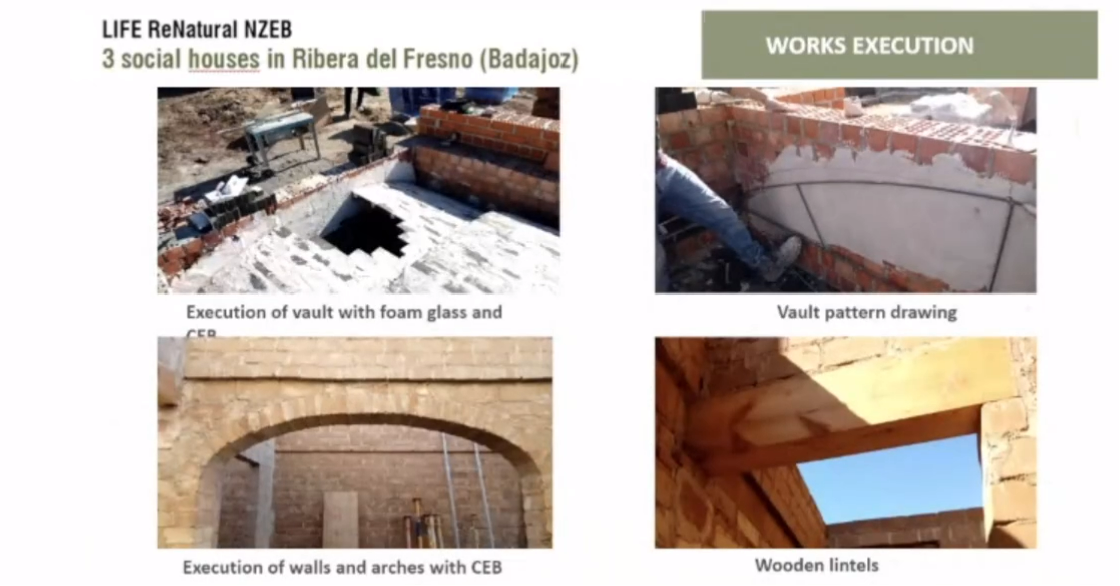
The vault, shaped like an arch, was constructed using compressed earth blocks (CEB), wood wool, foam glass, and wooden beams. This information was gathered from Lydia Lopez's presentation.
All of these materials are natural or recycled, available at a low cost, and come in small pieces for easy handling.
Maximum use of roofs
Rotterdam, Netherlands, was extensively bombarded during World War II and was essentially rebuilt from the ground up. Paul Van Rosmalen, a representative from the municipality of Rotterdam, stated that the entire city was almost completely destroyed and had to be reconstructed into a modern metropolis with numerous skyscrapers, but unfortunately, lacking in greenery and bodies of water.
He says that cities frequently have a shortage of space.
"Well, we actually have many roofs. Those rooftops are valuable because they give our city the space we need for various purposes. That's why we came up with a system of color codes to identify the different functions of the roofs," he clarified.

In his presentation, Paul Van Rosmalen demonstrates how roofs provide the city with additional space.
Roofs have various functions:
- Green roofs provide space for nature and promote biodiversity.
- Blue roofs are designed to retain and collect rainwater.
- Yellow roofs utilize renewable energy through solar panels or even windmills, making it a sustainable option.
- Red roofs can serve as unique meeting places for people if adequately designed.
- Orange roofs can be used in transportation, such as for parcel delivery or even the possibility of flying taxis.
- Purple roofs are suitable for sealing and can be utilized in constructing new housing.
- Gray roofs offer utility services and can serve as backup power sources.
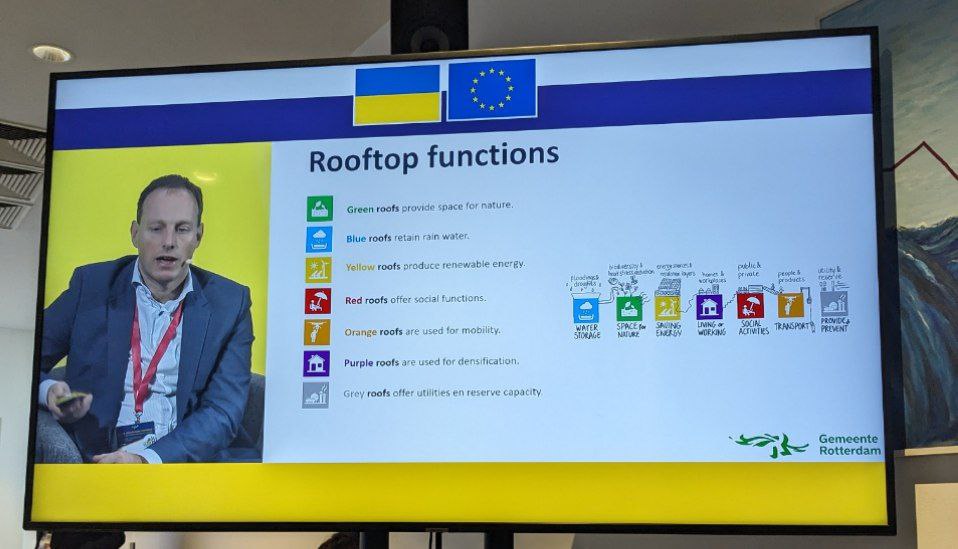
Paul Van Rosmalen presented the different options for utilizing roofs.
"We came up with golden combinations by connecting all the aspects. When looking at the project as a whole, incorporating features whenever possible makes it more intriguing and feasible. Additionally, we take a place-based approach, recognizing that each part of the city has its own unique characteristics," Paul elaborated.
A unique tool was developed to compute all potential combinations. It aids in determining the various potential returns and options for capitalizing on specific roofs.
Paul explained, "The tool displays the business case in a traditional return on investment format."
Use of waterproof coatings
Viimsi is a town in Northern Estonia situated on the eastern coast of Tallinn Bay in the Baltic Sea. It has a population of around 22,000 residents. According to Tanel Myatlik, a resident of Viimsi, the local government has begun implementing environmental initiatives in response to the tangible effects of climate change on the community.
"For instance, storms result in flooding along coastal regions. Moreover, a noticeable increase in heavy rain occurrences, particularly during the fall season, has resulted in floods in urban areas. Additionally, there is the pressing issue of heating the island," he explained.
Some natural solutions implemented include water-permeable and grass surfaces, drainage ponds and ditches, specialized slopes, and green roofs.
For instance, porous asphalt can absorb 30 liters of water within 10 seconds.
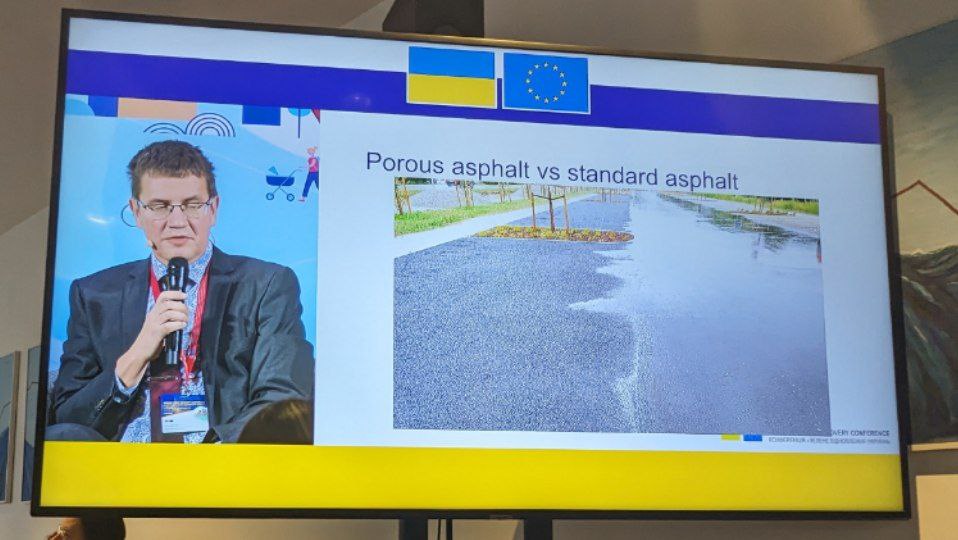
Tanel Myatlik demonstrates the difference between ordinary and porous asphalt
"We don't funnel all the rainwater into the pipes during heavy rainfall because they won't have enough capacity. Our solution is to provide permeable pavements and collect rainwater rather than trying to channel it into a pipe of limited size," he says.
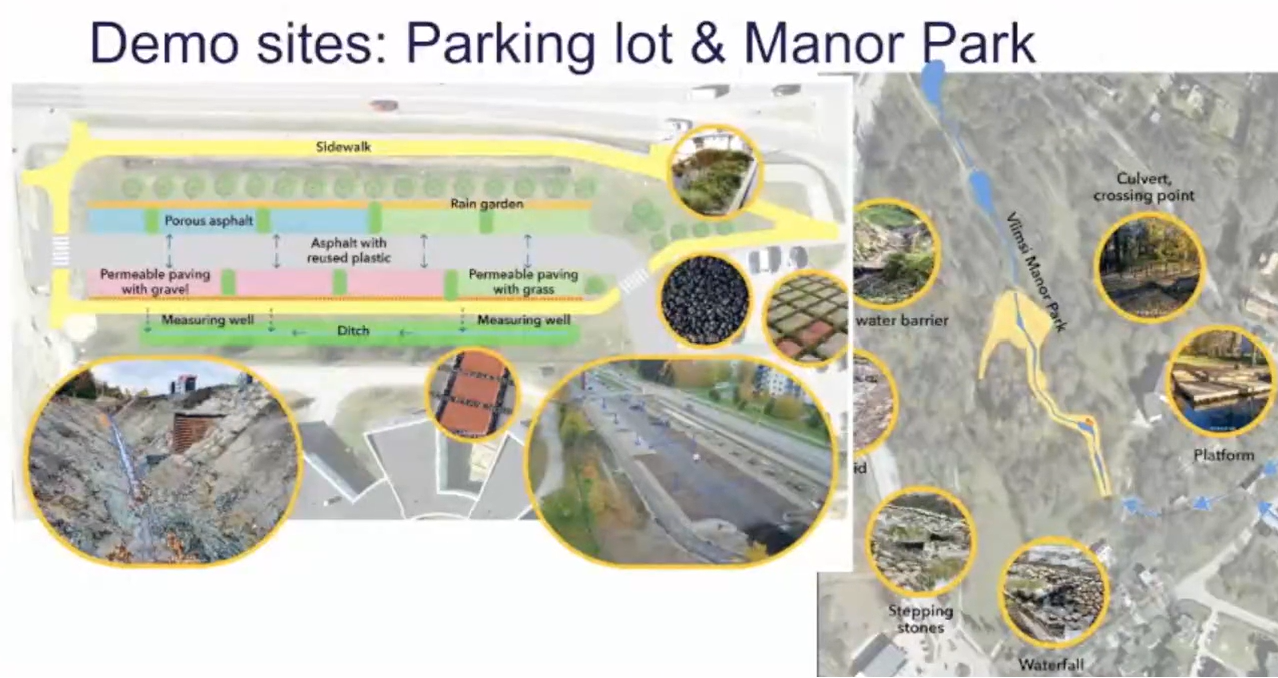
The tunnel displays a diagram of a parking lot and estate park that are designed to absorb water
Tanel Myatlik discussed a parking lot that utilizes multiple water-permeable coatings. The main section of the parking lot is covered by a layer of asphalt made from reused plastic. On the left side is a portion of porous asphalt and a "rain" garden. On the right side, there is a water-permeable pavement consisting of a combination of gravel and grass. The yellow color on the illustration represents the pavement surrounding the designated areas. A measuring well is also positioned along the side leading to the drainage ditch.
The municipality has also formed a team of stormwater management experts who quickly address emergencies.
Furthermore, a system for electronic monitoring has been developed.
"We're using digital monitoring techniques to receive advanced alerts about potential flooding hazards. This allows our specialist to take timely action based on the data gathered from various sources such as weather stations and other sensors," he explained.
Ecological tiles from recycled waste
The European Union's goal is to minimize the environmental impact caused by the construction industry through recycling and reusing construction materials.
The European Commission has identified Construction and Demolition Waste (CDW) as a major waste stream that requires special attention. This is because of the immense amount of waste produced (approximately 850 million tons per year) and the excellent potential for reusing and recycling it. Currently, most CDW is simply thrown into landfills, as it is typically mixed together and difficult to sort for recycling purposes.
During her presentation, Eleonora Paris, a University of Camerino in Italy representative, discussed the "LIFE ECO TILES" initiative. This project showcases how it is possible to make precast cement-based items (specifically terrazzo tiles) by recycling glass from municipal and industrial waste, as well as ceramics and CDW.
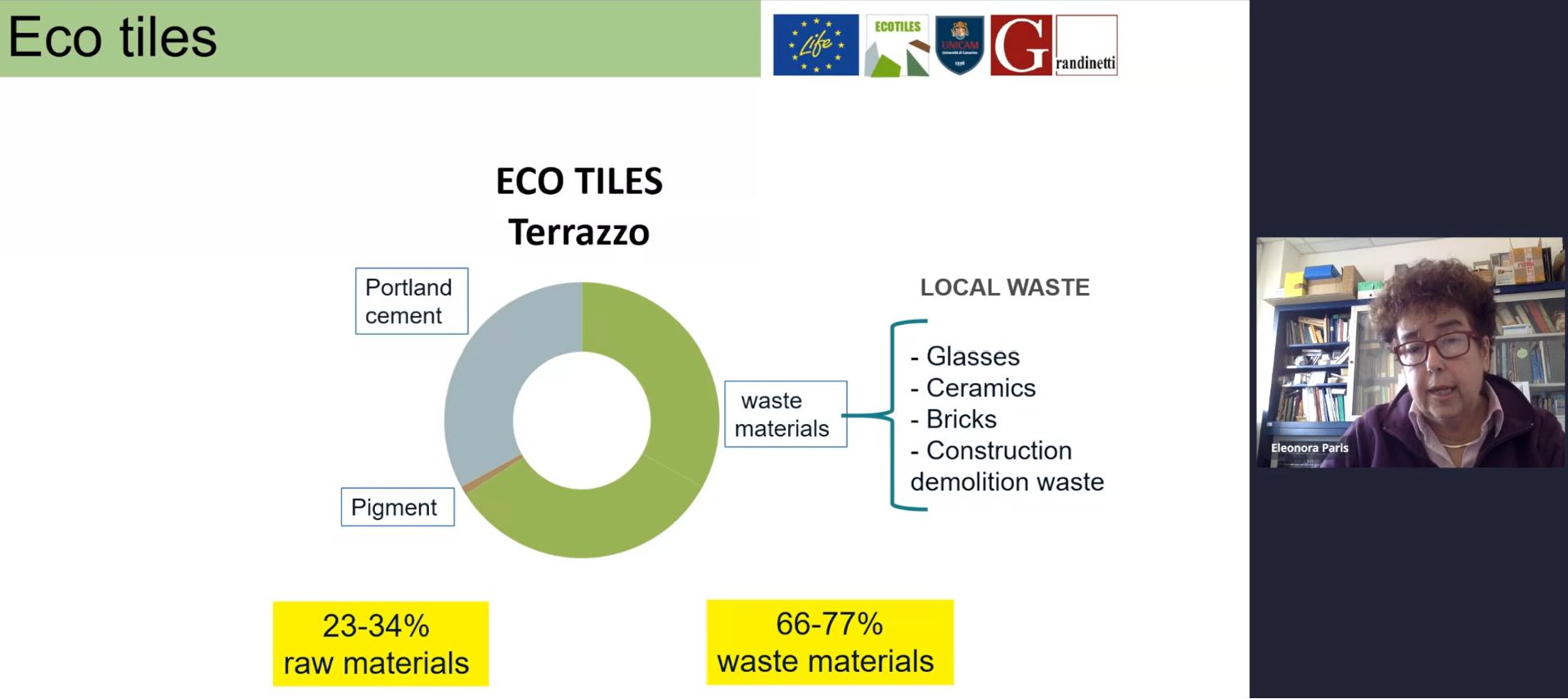
In her presentation, Eleonora Paris demonstrates the composition of Terrazzo eco-tiles
Terrazzo eco-tile comprises:
- a combination of raw materials (23-24%), including high-quality Portland cement and pigment,
- and waste (66-77%) such as glass, ceramics, bricks, and construction and demolition debris.
It should be noted that the production of these tiles has a significantly smaller (-20 %) impact on the environment.
The project is a collaboration between the University of Camerino's scientific expertise group in mineralogy and petrology (the study of rocks from a material composition perspective) and Grandinetti, an Italian company renowned for its production of traditional and artistic Terrazzo tiles, to study geomaterials.
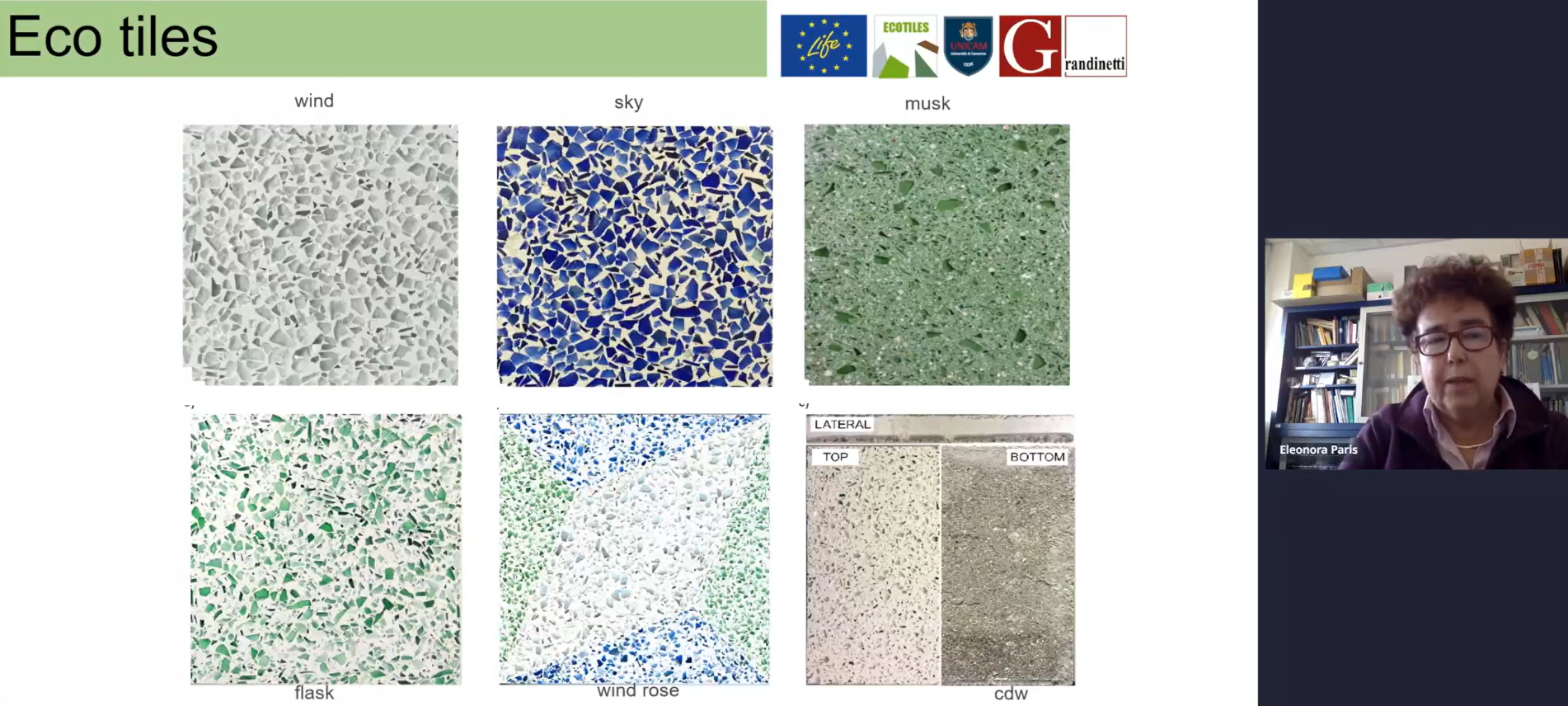
Eleonora Paris presented several types of eco-tiles in her presentation
"This may seem like a small project, but it has really inspired us, and we hope to expand it in the future. Moreover, it's a great concept for many companies since we have demonstrated how it can be successfully executed," Eleonora concluded.
Does it really work?
The Lithuanian President, Gitanas Nauseda, mentioned at the conference on Ukraine's "green" reconstruction that once the war is over, there is an opportunity for Ukraine to become a hub for the "green" economy. The EU is dedicated to supporting this goal.
The European Union provides financial assistance to Ukraine, ensuring environmental sustainability is considered in upcoming investments. Therefore, the European Commission has suggested allocating 50 billion euros to support Ukraine through the EU Ukraine Facility from 2024 to 2027.
The European initiative "Phoenix" has been receiving considerable attention lately. It is a unique combination of various programs by the European Commission that aim to assist Ukrainian politicians and civil society in achieving a "green" recovery. One key aspect of this initiative is a capacity-building program launched in March 2023 to assist municipalities in preparing for reconstruction. So far, 65 municipalities across Ukraine have joined this program. Additionally, in April 2023, a tender was issued for proposals worth 5 million euros, focusing on projects that will benefit Ukraine and the New European Bauhaus Academy. The winners of this tender will be announced by the end of this year.
Of course, the success of this endeavor also relies on the leadership of our state, local authorities, and civil society.
By Olena Bakonina
Newsletter
Digest of the most interesting news: just about the main thing





